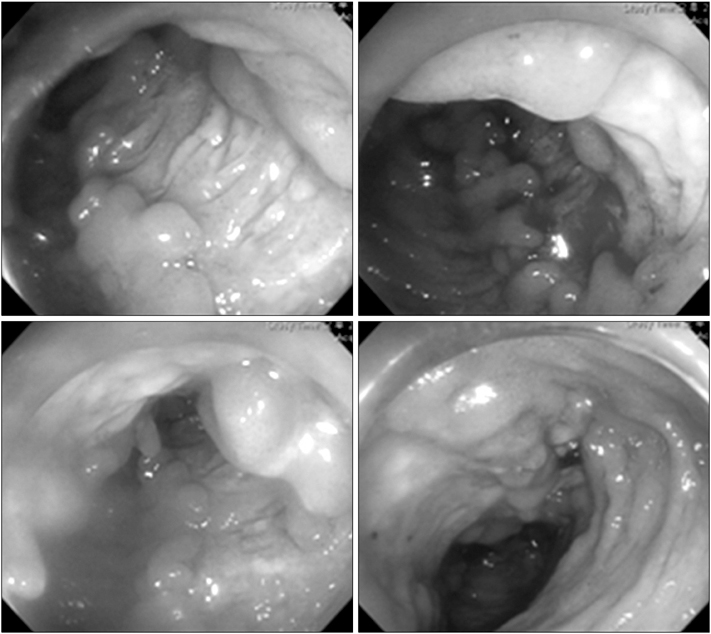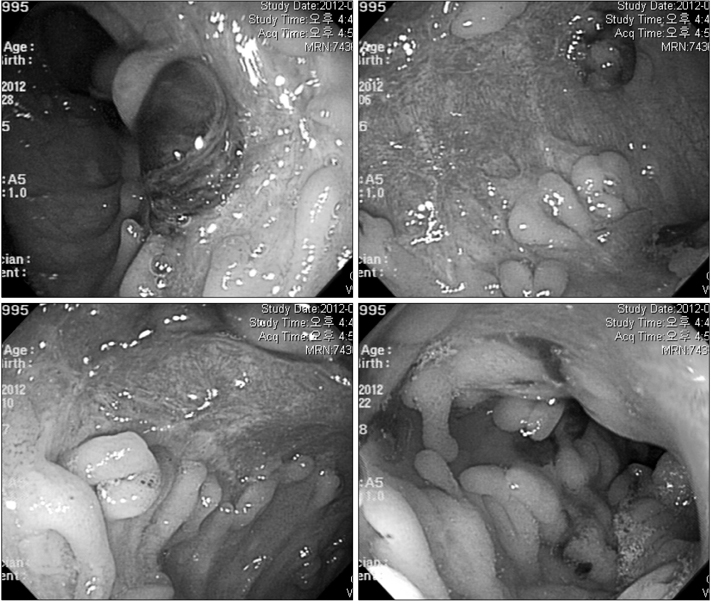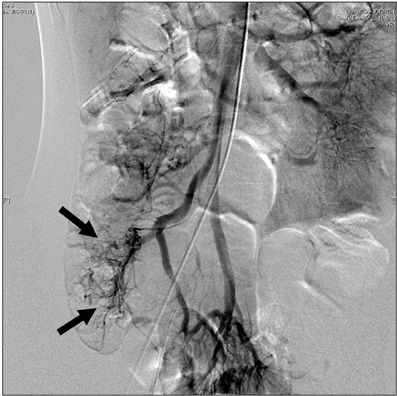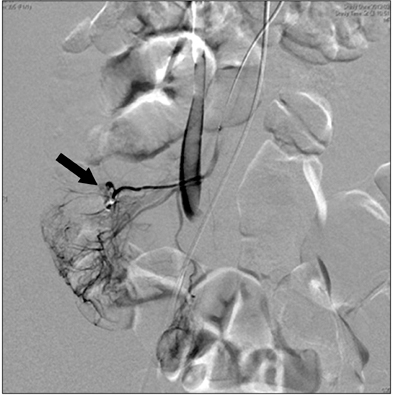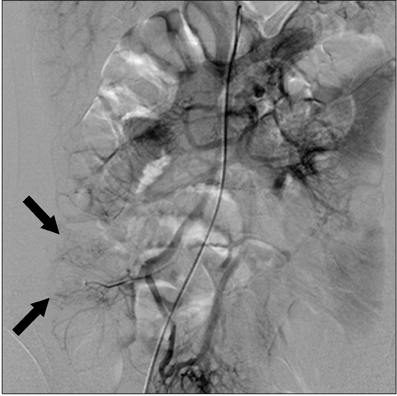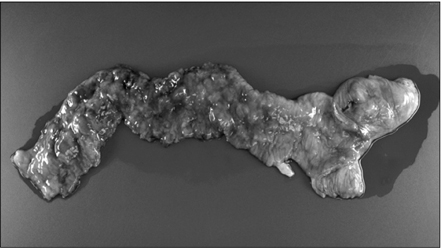Pediatr Gastroenterol Hepatol Nutr.
2013 Mar;16(1):53-60. 10.5223/pghn.2013.16.1.53.
Life-Threatening Lower Gastrointestinal Hemorrhage in Pediatric Crohn's Disease
- Affiliations
-
- 1Department of Pediatrics, Yonsei University College of Medicine, Seoul, Korea. khong@yuhs.ac
- 2Department of Diagnostic Radiology, Research Institute of Radiologic Science, Yonsei University College of Medicine, Seoul, Korea.
- 3Department of Pathology, Yonsei University College of Medicine, Seoul, Korea.
- 4Severance Pediatric Liver Disease Research Group, Severance Children's Hospital, Seoul, Korea.
- KMID: 1428808
- DOI: http://doi.org/10.5223/pghn.2013.16.1.53
Abstract
- In Crohn's disease, mild gastrointestinal bleeding often occurs; however massive gastrointestinal hemorrhage, which can have a dramatic effect on a patient's vital sign, is rare. This could result in potentially life-threatening complications, which can lead to death. Massive hemorrhagic Crohn's disease is not well known and for this reason, they are a diagnostic and therapeutic challenge. Various diagnostic and therapeutic methods are currently being developed and used. The surgical method is often used only as a last measure since this approach has the risk of serious complications that may endanger patients. However, if massive bleeding continues even after all therapeutic methods are used, the surgical method must be implemented. In this case, all therapeutic methods were found to be ineffective; therefore, surgery was used as a last option. Ultimately, the surgical method was found to be successfully used to treat life-threatening hemorrhagic Crohn's disease.
Figure
Reference
-
1. Fascì Spurio F, Aratari A, Margagnoni G, Doddato MT, Papi C. Early treatment in Crohn's disease: do we have enough evidence to reverse the therapeutic pyramid? J Gastrointestin Liver Dis. 2012. 21:67–73.2. Kim HA, Chung SS, Kim KH, Lee RA. The change of the clinical features that Crohn's disease treated by surgery. J Korean Surg Soc. 2005. 69:135–138.3. Lee NY, Park JH. Clinical features and course of crohn disease in children. Korean J Gastrointest Endosc. 2007. 34:193–199.4. Kazama Y, Watanabe T, Akahane M, Yoshioka N, Ohtomo K, Nagawa H. Crohn's disease with life-threatening hemorrhage from terminal ileum: successful control by superselective arterial embolization. J Gastroenterol. 2005. 40:1155–1157.
Article5. Alla VM, Ojili V, Gorthi J, Csordas A, Yellapu RK. Revisiting the past: intra-arterial vasopressin for severe gastrointestinal bleeding in Crohn's disease. J Crohns Colitis. 2010. 4:479–482.
Article6. Bae JW, Ko BS, Kim DH, Jeon HJ, Park SM, Youn SC, et al. A case of Crohn's disease with blood pressure falling intestinal bleeding. Korean J Gastrointest Endosc. 1998. 18:271–275.7. Cirocco WC, Reilly JC, Rusin LC. Life-threatening hemorrhage and exsanguination from Crohn's disease. Report of four cases. Dis Colon Rectum. 1995. 38:85–95.8. Iiritano E, Grassia R, Staiano T, Buffoli F. Life-threatening jejunal hemorrhage as first presentation of Crohn's disease. Inflamm Bowel Dis. 2010. 16:1277–1278.
Article9. Di Fiore F, Lecleire S, Hervé S, Savoye G, Lerebours E. Life-threatening bleeding revealing gastric involvement in a Crohn's disease patient. J Clin Gastroenterol. 2004. 38:833–834.
Article10. Ando Y, Matsushita M, Kawamata S, Shimatani M, Fujii T, Okazaki K. Infliximab for severe gastrointestinal bleeding in Crohn's disease. Inflamm Bowel Dis. 2009. 15:483–484.
Article11. Ye BD, Yang SK, Shin SJ, Lee KM, Jang BI, Cheon JH, et al. IBD Study Group of the Korean Association for the Study of the Intestinal Diseases. Guidelines for the management of Crohn's disease. Korean J Gastroenterol. 2012. 59:141–179.
Article12. Lee YJ, Oh SH, Kim KM. The principles of drug therapy of Crohn's disease in child and adolescent. Korean J Pediatr Gastroenterol Nutr. 2010. 13:Suppl 1. S59–S69.
Article13. Gardiner KR, Dasari BV. Operative management of small bowel Crohn's disease. Surg Clin North Am. 2007. 87:587–610.
Article14. Voitk AJ, Echave V, Feller JH, Brown RA, Gurd FN. Experience with elemental diet in the treatment of inflammatory bowel disease. Is this primary therapy? Arch Surg. 1973. 107:329–333.
Article15. Podolny GA. Crohn's disease presenting with massive lower gastrointestinal hemorrhage. AJR Am J Roentgenol. 1978. 130:368–370.
Article16. Barreiro de Acosta M, Seijo Ríos S, Domínguez Muñoz JE. Life-threatening acute lower gastrointestinal bleeding in patients with Crohn's disease. Rev Esp Enferm Dig. 2007. 99:388–391.17. Suh HA, Kim SE, Jang JY, Kim BJ, Kim JS, Lee SY, et al. Efficacy of nutritional therapy in children with Crohn disease. Korean J Pediatr Gastroenterol Nutr. 2006. 9:210–217.
Article18. Lee KM, Kim JS, Shin DH, Cheong JY, Yoo BM, Kim JK, et al. Effect of infliximab in the treatment of refractory inflammatory bowel disease with complication. Korean J Gastroenterol. 2004. 44:259–266.19. Kim SH, Yang S, Kim KJ, Kim EH, Yoon SM, Ye BD, et al. Efficacy of infliximab in the treatment of Korean patients with crohns disease. Korean J Gastroenterol. 2009. 54:108–116.
Article20. Ryu MK, Kim YH, Hyun JG, Moon W, Lee KS, Lee SS, et al. Clinical investigations of Crohn's disease in Korea. Korean J Med. 2001. 60:46–50.
- Full Text Links
- Actions
-
Cited
- CITED
-
- Close
- Share
- Similar articles
-
- A Case of Crohn's Disease with Iliac Arterio-Enteric Fistulae
- A Case of Crohn's Disease with Blood Pressure Falling Intestinal Bleeding
- Clinical Characteristics of Lower Gastrointestinal Cancer in Crohn's Disease: Case Series of 5 Patients
- Change in the treatment strategy for pediatric Crohn's disease
- Isolated Duodenal Crohn's Disease: A case report

